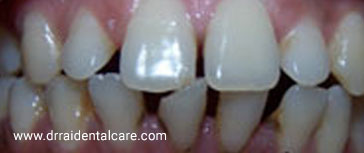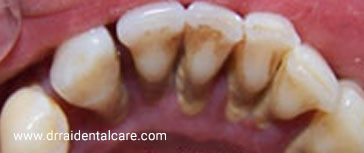Gum disease, commonly referred to as periodontal disease and pyorrhea, is the disease that affects the gums and other supporting structures of the teeth.
The most common cause is poor oral hygiene or inadequate cleaning of the mouth. New studies indicate heredity may play a role in your susceptibility to gum disease. A study published in the Journal of Clinical Period-ontology found that up to 30 percent of the population may be genetically susceptible to developing severe periodontal disease.


Diabetics or a history of diabetes in your family increases your risk to gum disease.
Habits such as smoking, consumption of pan and pan masala, chewing tobacco, gutka etc. are contributing factors which can lead to increased incidence of gum disease.
Medications such as Dilantin and Coumadin also increase the chances of gum disease.
Patients often confuse plaque and tartar and their relationship to each other. Plaque is a sticky, colorless deposit of bacteria that constantly forms on the teeth. Saliva, food and fluids combine to produce this plaque. If it is not removed by regular brushing and flossing, it hardens and calcifies to form a stone like crusty deposit, commonly referred to as tartar or calculus. Tartar binds firmly to the teeth and can only be removed by a dentist.
Healthy gums are pink in color, firm with well defined, pointed tips. Teeth fit snugly in the jawbone, their roots surrounded by a strong foundation of gums and supporting bone.
This is the early stage of gum disease. It is characterized by a mild inflammation of the gums caused by plaque buildup, which may be red and sore, and bleed easily upon brushing.
Periodontitis : If gingivitis is left untreated, the plaque build up spreads below the gum line and causes an infection of supporting bone and gum tissues. The tartar causes the gum to swell and separate from the tooth forming a pocket between the teeth and the bones. The underlying bone also deteriorates.
Advanced Periodontitis : As the infection persists and the calculus build up grows, the gums recede farther and swell more. Pus may develop, bone loss continues, and the teeth may loosen and even eventually fall out.
Gum disease is clinically detected by the following methods:
In the early stages, scaling the teeth can treat gum disease. This is a procedure where the teeth are cleaned using an ultrasonic scaler and the plaque and tartar is removed.
As the disease progresses, the calculus accumulates under the gum. This becomes impossible to clean without surgery. Here the gums are opened and access is obtained to the parts of the tooth, which are under the gums. They are then cleaned and all the infective material is removed. In cases where a lot of bone has been destroyed, an artificial bone supplement may be used to help regenerate some of the lost bone and increase support to the teeth.
The only effective way of preventing gum disease is to prevent or minimize the build up of plaque and the formation of calculus. The best way is to brush and floss your teeth regularly twice a day. People with advanced stages of gum disease may need to use accessory gadgets to enable them to clean thoroughly. Details of preventive techniques are given in the section on preventive dentistry.
A balanced diet especially one rich in dietary fibre is recommended. Fresh fruits, vegetables, milk and fish are advisable.
Regular bi-annual visits to the dentist are advisable. This ensures detection and hence treatment of the disease at a very early stage.
The connection between gum disease and heart disease, as well as gum disease and strokes, has recently received a lot of attention. Previous studies indicate that people who have severe periodontitis are more likely to develop heart disease than those who do not have periodontal problems. The bacteria, which cause plaque also, may cause white blood cells to release clotting factors and proteins. These biochemicals in turn contribute to heart disease and stroke.
The early stages of gingivitis are completely reversible with professional treatment and regular follow-ups. In advanced stages of periodontitis, dental treatment can stop further deterioration of the gum and the bone. However the changes are not reversible.
Plaque begins forming on teeth 4 to 12 hours after brushing which is why it is so important to brush at least twice a day and floss daily.
Change your brush once every 3 months. In an old brush, the bristles tend to splay and hence do not clean effectively.
Tartar control toothpaste reduces the severity of tartar formation and makes its removal somewhat easier for the patient.
Yes, flossing if done properly is extremely effective. However if the proper technique is not followed, it can cause dam
Millions of bacteria are present in the mouth. In medically compromised patients such as those with a damaged heart valve or Prosthetic valve even a routine cleaning can cause these bacteria to enter the blood stream produce a life threatening infection. In diabetic patients too the chances of a flare up of infection is more. In such cases premedication may be advisable.
The water-pik is an extremely effective adjunct for maintaining oral hygiene. It comprises of a tank, which holds the water/mouthwash, and a nozzle from which a jet of water is released. The nozzle is directed along the gums and the pressure of the water helps to remove stagnant food particles and also provides a gum massage. It is very useful for people with extensive bridgework or patients with braces. Although not completely effective in plaque removal it can be helpful in reducing gingivitis especially when used with a suitable mouthwash.